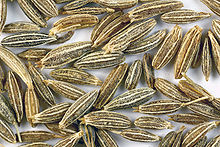sister herb
Official TTI Chef

Cumin, sometimes spelled cummin; Cuminum cyminum), also known as Jeera, is a flowering plant in the family Apiaceae, native from the east Mediterranean to India. Its seeds (each one contained within a fruit, which is dried) are used in the cuisines of many different cultures, in both whole and ground form. In addition, it is also used as a medicinal plant, serving as a digestant, as well as being used to treat anemia and the common cold.
Cumin has been in use since ancient times. Seeds excavated in India have been dated to the second millennium BC. They have also been reported from several New Kingdom levels of ancient Egyptian archaeological sites. In the ancient Egyptian civilisation cumin was used as spice and as preservative in mummification.
Originally cultivated in Iran and the Mediterranean region. The ancient Greeks kept cumin at the dining table in its own container (much as pepper is frequently kept today), and this practice continues in Morocco. Cumin was also used heavily in ancient Roman cuisine. In India, it has been used for millennia as a traditional ingredient of innumerable kormas, masalas, and soups, and forms the basis of many other spice blends.
Cumin was introduced to the Americas by Spanish and Portuguese colonists. There are several different types of cumin but the most famous ones are black and green cumin, both of which are used in Persian cuisine.
Today, the plant is mostly grown in China, Uzbekistan, Tajikistan, Iran, Turkey, Morocco, Egypt, Syria, Mexico, Chile and India. Since cumin is often used as part of birdseed and exported to many countries, the plant can occur as a rare casual in many territories including Britain. Cumin occurs as a rare casual in the British Isles, mainly in Southern England; but the frequency of its occurrence has declined greatly. According to the Botanical Society of the British Isles' most recent Atlas, only one record has been confirmed since 2000.
Cumin seeds are used as a spice for their distinctive flavour and aroma. It is globally popular and an essential flavouring in many cuisines, particularly South Asian, Northern African and Latin American cuisines. Cumin can be found in some cheeses, such as Leyden cheese, and in some traditional breads from France. It is commonly used in traditional Brazilian cuisine. Cumin can be an ingredient in chili powder (often Tex-Mex or Mexican-style), and is found in achiote blends, adobos, sofrito, garam masala, curry powder, and bahaarat. In Myanmar, cumin is known as "zi yar" and used as a spice.
Cumin can be used ground or as whole seeds. It helps to add an earthy and warming feeling to food, making it a staple in certain stews and soups, as well as spiced gravies such as chili. It is also used as an ingredient in some pickles and pastries.
Medicinal uses
In Sanskrit, Cumin is known as Jira. Jira means “that which helps digestion". In Ayurvedic system of medicine, dried Cumin seeds are used for medicinal purposes. The dried cumin seeds are powdered and used in different forms like kashaya (decoction), arishta (fermented decoction), vati(tablet/pills), and processed with ghee (a semi-fluid clarified butter). It is used internally and sometimes for external application also. It is known for its actions like enhancing appetite, taste perception, digestion, vision, strength, and lactation. It is used to treat diseases like fever, loss of appetite, diarrhea, vomiting, abdominal distension, edema and puerperal disorders.
A popular drink in southern India such as Kerala and Tamil Nadu is called jira water, made by boiling cumin seeds in water. It is believed that cumin is beneficial for heart disease, swellings, tastelessness, vomiting, poor digestion and chronic fever.
Cumin has many pharmacological effects such as anti-diabetic, immunologic, anti-epileptic, anti-tumour and antimicrobial activities. A study by researchers at Mysore University in India reports the potential anti-diabetic properties of cumin.
According to the authors, cumin seeds and warm jeera water is believed to improve saliva secretion, provide relief in digestive disorders.
Cumin is sometimes confused with caraway (Carum carvi), another umbelliferous spice. Cumin, though, is hotter to the taste, lighter in colour, and larger. Many European languages do not distinguish clearly between the two. Many Slavic and Uralic languages refer to cumin as "Roman caraway". Examples include Czech: kmín – caraway, římský kmín -cumin; Polish: kminek – caraway, kmin rzymski – cumin; Hungarian: kömény – caraway, római kömény – cumin. Finnish: kumina – caraway, roomankumina – cumin, although sometimes also called juustokumina, cheese caraway. In Norwegian, caraway is called both karve and kummin/kømming while cumin is spisskummen, from the word spise, to eat. Similarly in Swedish and Danish, caraway is kummin/kommen, while cumin is spiskummin/spidskommen. In German, Kümmel stands for caraway and Kreuzkümmel denotes cumin. In Icelandic, caraway is kúmen, while cumin is kúmín. In Romanian, chimen is caraway, while chimion is cumin.
The distantly related Bunium persicum and the unrelated Nigella sativa are both sometimes called black cumin.
Last edited:








